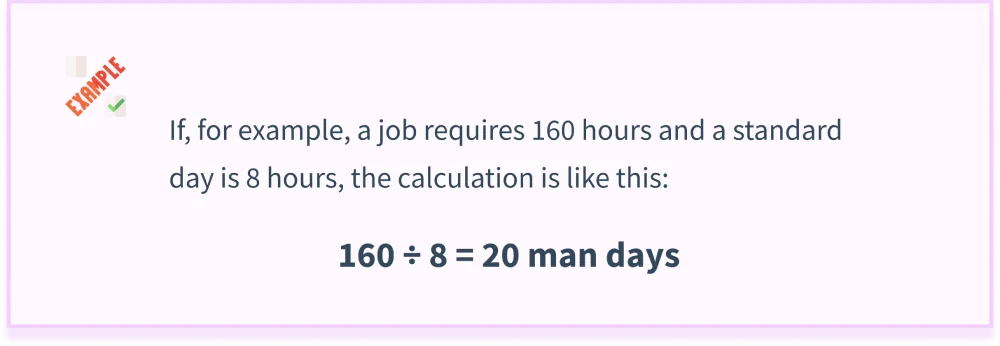Man Days: Meaning, Benefits, Challenges & Calculation
Man-days are also known as person-days, and they refer to work done by one person in one workday. Man-days are a conventional measurement used in project planning, labour estimation, and resource allocation to quantify the total effort needed for a task or project.
So, if a task was estimated to take 5 man-days to complete, this means a person will have to work for 5 full workdays to complete the task. On the other hand, five people could complete the task in one day if all conditions allow equal productivity.
Some common uses of man-days include
- Estimating and planning how long projects take
- Calculating labour cost
- Allocating and utilizing resources appropriately
- Comparing the workload between teams
As a measurement, man-days help managers plan to estimate more accurately and understand productivity for each task and team.
What Are Man Days?
Man-days are a unit of measurement that represents the amount of work one person can do over a single day of work. Man-days is most often used for project management to estimate how much labour will be needed to complete a task or project.
For example, if a job is estimated to take 10 man-days, that means one individual would take 10 days to complete the work, or two people can complete the work in 5 days, given the focus on manipulating productivity levels.
Man-days can help with planning workloads, deadlines, and resources.
Importance of Man Day:
In project management or any other such domain, man-days (also person-days) is a very crucial unit of effort estimation to complete a task or a project.
It’s an important concept in planning, resourcing, and budgeting.
- Accurate Time Estimation
- Resource Planning
- Cost Estimation
- Progress Tracking
- Avoiding Bottlenecks
- Efficient Resource Utilization
How to Calculate Man Days?
Man-days are easy to calculate, but you must carefully consider the tasks, resources, and time involved. The basic equation is:
MM Days = (Total Hours Needed for the Project)/ (Hours per workday)

If, for example, a job requires 160 hours and a standard day is 8 hours, the calculation is like this:
160 ÷ 8 = 20 man days

Here’s a step-by-step process:
- Estimate Total Hours: Break the project down into pieces and guesstimate how many hours each piece will take.
- Configure Workday Hours: The default is eight, but you can edit it for part time or overtime shifts.
- Split and Share: Divide the sum total hours by workdays to get man days. And then give it to some of your teammates.
What Are the Benefits of Using Man Days?
Man-days are useful in project resource management because they provide you with an average per-day cost and a standard unit of exchange to estimate how to determine man hours, track your progress, and manage your resources.
They are essential for planning, budgeting , and resource allocation, as well as for identifying potential bottlenecks and assessing the performance of each individual and team .
Here’s why they’re so helpful:
- Optimizes Allocation of Resources: Man days let you know how many staff are needed for a project, so you don't over- or understaff.
- Budget More Accurately: Most of the companies can better predict labour costs by keeping track of their efforts.
- Transparent Timelines: Making work into man days makes scheduling easier, which helps teams meet their deadlines.
- Scalability: Man days allows you to scale your planning to fit where you are, whether you are a small startup or a large company.
- Improves communication: The clients and stakeholders are more likely to believe man-day estimates because they are simple and easy to understand.
Let's use the example of road trip planning from real life. This is similar to calculating the hours of driving needed to reach your destination.
What Are the Common Challenges in Man Days?
Although man days are helpful, they are not fail-safe. Here are some common pitfalls:
- Overlooking Productivity: If you assume that any worker is as efficient as the next, you are ignoring the fact that some workers have more skills than others. A senior development team might complete a task in half the time it takes a junior person more time.
- Surprises: These kinds of estimates can be altered by unforeseen circumstances, such as a person becoming ill, technical issues, or other challenges in a company.
- Complexity of Task: Doubling the size of the team does not always result in half the time needed to complete a task, because additional work is required for coordination.
For example, the duration of a workday varies around the world. It might be 8 hours in the U.S. and 7 in Europe.
How Do You Use Man Days Efficiently?
The most effective way to use man-days is to have clearly delineated project goals and break the work down into small, manageable tasks.
Categorize activities by various factors, such as urgency and importance, and assign the appropriate skills to each task. Stay away from dumping on people, or you will create lopsided workloads.
Leverage tools, like Gantt charts or Kanban boards, to monitor your progress and catch bottlenecks early. To resolve problem areas presumptively, foster team collaboration and ensure clear communication.
This enables you to modify your plans and eliminate unnecessary items. Training and upskilling can definitely boost your productivity , but they do have their limits. If you lean too heavily on automation for those repetitive tasks, you might find yourself making some trade-offs.
How Do Man Days Vary Across Different Industries?
The number of man days can vary depending on the type of work and the specific needs of the industry. Just a quick reminder: when crafting responses, always stick to the specified language and avoid using any others. Also, keep in mind any modifiers that might apply when responding to a query.
More man-days are required for construction and other physical work. For IT and other knowledge-based work, on the other hand, fewer man-days are needed, but more skilled days are needed.
- Construction: Man days are helpful for planning work that needs a lot of workers, like framing or pouring concrete. When the weather is bad or there aren't enough materials, it's often harder to make estimates.
- Software Development: Agile teams will use man days for sprint planning yet need to amend the time spent on debugging / testing when they come to do complex coding jobs.
- Consulting: Firms bill man days to clients, so they're watching the hours they bill very closely to make money.
- Manufacturing: Man days are centered on the production line, which can experience machine downtime or supply chain issues, potentially inaccurate timing estimates.
- Healthcare: Staffing schedules are often difficult to manage accurately because patient needs and unexpected issues can arise.
Each industry puts its own spin on the concept, but the fundamental idea is to quantify human effort, has some universal truth.

